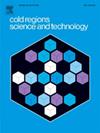模拟冻胀的九种土壤冻结特性曲线模型的比较分析
IF 3.8
2区 工程技术
Q1 ENGINEERING, CIVIL
引用次数: 0
摘要
冻土冻结特性曲线(SFCC)是冻土的基本关系,是冻胀数值模拟的重要输入参数。本文对常用的9种SFCC模型进行了系统比较,评价了它们在模拟冻胀中的性能。9个SFCC模型分为经验模型和基于swcc的模型,霜胀计算采用了两种方法:量化土壤体积变化的孔隙比法和累积冰透镜随时间增长的冰透镜法。结果表明,XU2001(基于幂函数的)以其简单性,误差控制在2mm以内,相关系数在80%以上而排名最高,是经验模拟的理想选择。其次是AN1973(一种集成多种函数类型的混合方法),MK2007(基于指数函数)和JA1977(基于分段线性函数)表现出中等的性能。TI1976(含冰量幂函数)由于参数敏感性排名最低。与经验SFCC模型相比,基于swcc的模型仅通过试验数据而不是土壤性质来确定参数,具有更强的稳定性和更高的精度。平均评价指标表明,空隙率法计算的冻胀能较好地反映冻胀的变化趋势,而冰透镜厚度积分法计算的冻胀在计算中更为稳定。结果还表明,对于粘土等渗透性系数较低的土,用冰透镜厚度积分法计算的冻胀比用孔隙比法计算的冻胀更准确,而对于渗透性系数较高的粉质土和砂质土,二者差异不大。本文章由计算机程序翻译,如有差异,请以英文原文为准。
Comparative analysis of nine categories of soil freezing characteristic curve models for simulating frost heave
The relationship between unfrozen water content and subzero temperature is defined as the soil freezing characteristic curve (SFCC), which is a fundamental relation for frozen soil and is an input parameter of great importance in numerically modeling frost heave. This study makes a systematic comparison of nine common SFCC models to evaluate their performances in simulating frost heave. The nine SFCC models are divided into empirical models and SWCC-based models, and two approaches are used for frost heave computation: the void ratio method, which quantifies soil volume changes, and the ice lens method, which accumulates ice lens growth over time. The results show that XU2001 (power function-based) ranks highest for its simplicity, deviation control within 2 mm, and a correlation coefficient above 80 %, making it ideal for empirical simulations. AN1973 (a hybrid approach integrating multiple function types) follows, with MK2007 (exponential function-based) and JA1977 (piecewise linear function-based) showing moderate performance. TI1976 (power function with ice content) ranks lowest due to parameter sensitivity. Compared to empirical SFCC models, SWCC-based models determine parameters solely through test data rather than soil properties, resulting in greater stability and higher accuracy. The average evaluation metrics show that the frost heave computed by the void ratio approach can better reflect the changing trend of frost heave, but the frost heave computed by the integration of the ice lens thickness approach is more stable in the calculation. The results also indicate that the frost heave evaluated by the approach of integrating ice lens thickness is more accurate than that by analyzing void ratio for the soil with a lower permeability coefficient like clay, while they have little difference for the silty and sandy soil that has a higher permeability coefficient.
求助全文
通过发布文献求助,成功后即可免费获取论文全文。
去求助
来源期刊

Cold Regions Science and Technology
工程技术-地球科学综合
CiteScore
7.40
自引率
12.20%
发文量
209
审稿时长
4.9 months
期刊介绍:
Cold Regions Science and Technology is an international journal dealing with the science and technical problems of cold environments in both the polar regions and more temperate locations. It includes fundamental aspects of cryospheric sciences which have applications for cold regions problems as well as engineering topics which relate to the cryosphere.
Emphasis is given to applied science with broad coverage of the physical and mechanical aspects of ice (including glaciers and sea ice), snow and snow avalanches, ice-water systems, ice-bonded soils and permafrost.
Relevant aspects of Earth science, materials science, offshore and river ice engineering are also of primary interest. These include icing of ships and structures as well as trafficability in cold environments. Technological advances for cold regions in research, development, and engineering practice are relevant to the journal. Theoretical papers must include a detailed discussion of the potential application of the theory to address cold regions problems. The journal serves a wide range of specialists, providing a medium for interdisciplinary communication and a convenient source of reference.
 求助内容:
求助内容: 应助结果提醒方式:
应助结果提醒方式:


